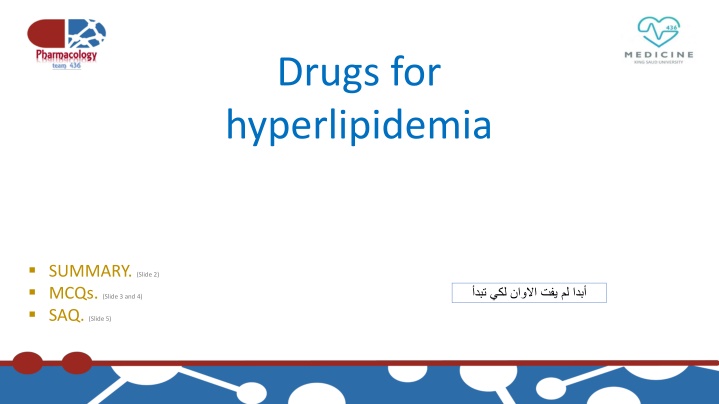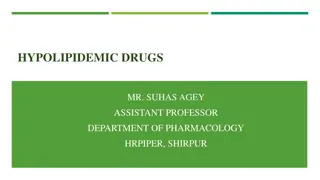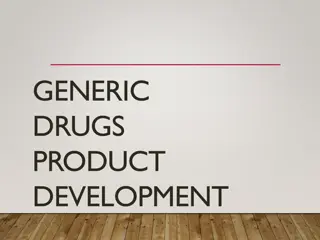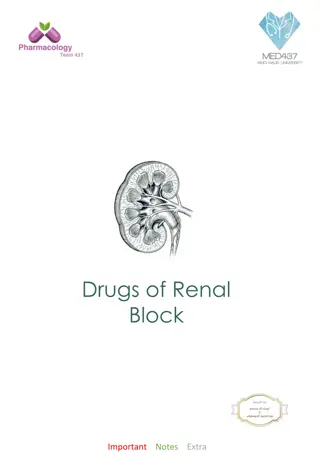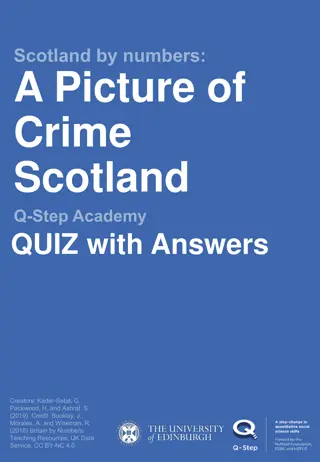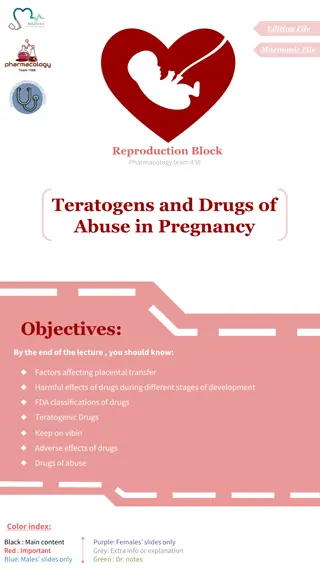Drugs for Hyperlipidemia Summary and Quiz MCQs
This presentation covers drugs for hyperlipidemia, including bile acid sequestrants, cholesterol absorption inhibitors, statins, fibrates, and relevant drug interactions. It details the actions, adverse effects, contraindications, and notable considerations for each drug class. The included multiple-choice questions test knowledge on drug mechanisms and interactions in hyperlipidemia management.
Download Presentation

Please find below an Image/Link to download the presentation.
The content on the website is provided AS IS for your information and personal use only. It may not be sold, licensed, or shared on other websites without obtaining consent from the author.If you encounter any issues during the download, it is possible that the publisher has removed the file from their server.
You are allowed to download the files provided on this website for personal or commercial use, subject to the condition that they are used lawfully. All files are the property of their respective owners.
The content on the website is provided AS IS for your information and personal use only. It may not be sold, licensed, or shared on other websites without obtaining consent from the author.
E N D
Presentation Transcript
Drugs for hyperlipidemia SUMMARY. (Slide 2) MCQs. (Slide 3 and 4) SAQ. (Slide 5)
Target Class Drug Action ADRs Effect (%change) Notes Contraindications: 1- Complete biliary obstruction 2- Chronic constipation 3-Severe hypertriglyceridemia (TG >400 mg/dL) GI distress, constipation, decreased absorption of other drugs (Statins, Ezetimibe Chlothiazides, Digoxin, Warfarin) Colesevelam does not interfere with absorption of other drugs Form an insoluble complex with the bile acids and salts, preventing their reabsorption from the intestine and disrupting the enterohepatic circulation of bile acids. LDL HDL Cholestyramine Colestipol Colesevelam Bile Acid sequestrants No change in triglycerides Exogenous Cholesterol Monotherapy: primary prevention of low risk CHD. Combination therapy: safe: with statins or fibrates Ezetimibe reduces C absorption. Therefore, ezetimibe reduces the flux of C from the intestine to the liver. LDL( 14-18), HDL (1-3) Triglyceride (2) Not common GIT disturbance, headache, fatigue, artheralgia & myalgia Cholesterol absorption inhibitor Ezetimibe Common: Headache , myalgia, fatigue, GI intolerance, and flu-like symptoms Hepatotoxicity, Teratogenicity. Muscle aches, or weakness associated with an elevation of creatine kinase (CK) released from muscles, are the best indicator of statin-induced myopathy Simvastatin Lovastatin Atorvastatin Pravastatin Rosuvastatin LDL 18-55% Statins (HMG-Co A Reductase Inhibitors) It is important to check CK & liver enzymes regularly upon administration of statins. potent competitive inhibitors of HMG-CoA reductase HDL 5-10% TG & VLDL 10- 30% endogenous cholesterol In adipose tissue: it binds to adipose nicotinic acid receptors In liver:inhibits hepatocyte diacylglycerol acyltransferase-2 In plasma : it increase LPL activity Contra-indications Gout Peptic ulcer Hepatotoxicity Diabetes mellitus LDL (15-30), HDL (15-35) Triglyceride (20-50) Niacin (Nicotinic Acid) Flushing (+aspirin) Hyperglycemia, Hyperuricemia, GI distress, hepatotoxicity LDL (5-20), HDL (10-20) Triglyceride (20- 50) They increase gene transcription for lipoprotein lipase (LPL) leading to increased catabolism of TG in VLDL and chylomicrons Pregnant or nursing women ,Renal impairment,Gall-bladder disease,In alcoholics Clofibrate Fenofibrate Gemfibrozil Dyspepsia, gallstones, myopathy Fibrates 2
Online Quiz .. MCQs https://www.onlineexambuilder.com/pharmacology-anti-hyperlipidemia/exam-144715 Q1: Which one of the following drugs binds bile acids in the intestine, thus preventing their return to the liver via the enterohepatic circulation? A) Niacin. B) Fenofibrate. C) Cholestyramine. Q2: A 62-year-old female with hyperlipidemia and hypothyroidism. Her current medications include cholestyramine and levothyroxine (thyroid hormone). What advice would you give to her to avoid a drug interaction between her cholestyramine and levothyroxine? A) Stop taking the levothyroxine as it can interact with cholestyramine. B) Take levothyroxine 1 hour before cholestyramine on an empty stomach. C) Switch cholestyramine to colestipol as this will eliminate the interaction. D) Take levothyroxine and cholestyramine at the same time to minimize the interaction. D) Fluvastatin. Q3: Which of the following patient populations is more likely to experience myalgia (muscle pain) or myopathy with use of HMG CoA reductase inhibitors? A) Patients with diabetes mellitus. B) Patients with renal insufficiency. C) Patients with gout. D) Patients with hypertriglyceridemia. Q4: Which one of the following drugs decreases cholesterol synthesis by inhibiting the enzyme 3-hydroxy-3- methylglutaryl coenzyme A reductase? A) Fenofibrate. B) Niacin. C) Cholestyramine. D) Lovastatin. Q5: A 42-year-old man who was started on niacin sustained-release tablets 2 weeks ago for elevated triglycerides and low HDL levels. He is complaining of an uncomfortable flushing and itchy feeling that he thinks is related to the niacin. Which of the following options can help him manage this adverse effect of niacin therapy? A) Administer aspirin 30 minutes prior to taking niacin. B) Administer aspirin 30 minutes after taking niacin. C) Increase the dose of niacin to 1000 mg. D) Change the sustained-release niacin to immediate-release niacin. Q6: A 72-year-old female who is treated for hyperlipidemia with Pravastatin for the past 6 months.. Her physician wishes to add an additional agent to block absorption of exogenous cholesterol. Which of the following choices is the best option? A) Niacin. B) Colesevelam. C) Gemfibrozil. D) Ezetimibe. 6:D 5:A 4:D 3:B 2:B 1:C 3 Answers
Cont. MCQs Q7: Patient comes into the ER with gallstones, after further investigations You find out that he is on drugs to treat his hyperlipidemia. Which of the following drugs could have caused his gall stones? A) Niacin. B) Fenofibrate C) Ezetimibe D) Colesevelam Q8: A 65-year-old man who presents to his physician for management of hyperlipidemia. His most recent lipid panel reveals an LDL cholesterol level of 136 mg/ dL and very low HDL cholesterol about 28 mg/ dL. His physician wishes to begin treatment to increase his HDL cholesterol levels. Which of the following therapies is the best option to increase HDL cholesterol levels? A) Colesevelam. B) Niacin. C) Simvastatin. D) Ezetimibe. Q9: Patient with diabetes has hyperlipidemia, Which drug of the following can not be used in his case due the risk of development of Hyperglycemia? A) Niacin. B) Statins . C) Colestipol. D) Ezetimibe. Q10: Patient with hypercholesterolemia taking a combination of two anti hyperlipidemic drugs, After 4 days the patient complaining of sever myalagia and increase in creatine kinase. Which drugs did this patient use? A) Cholestyramine & Lovastatin. B) Fenofibrate & Ezetimibe. C) Lovastatin & Fenofibrate. D) niacin & Ezetimibe. Q11: Patient went to the hospital to check his blood cholesterol level and he had an increase in LDL, The doctor prescribes one of the an4 hyperlipidemia drugs with vitamins D and E supplement, What is the most likely drug the doctor prescribed? A) Statins. B) Colestipol. C) Ezetimibe. D) Nicotinic acid Q12: A 72-year-old male who is treated for hyperlipidemia with anti-hyperlipidemic agent for the past 6 months. He also has a history of sever constipation. His most recent lipid panel shows an LDL cholesterol level of 131 mg/dL, and high level of triglycerides of 510 mg/dL, and there is no change in HDL cholesterol. Which of the following drugs did this patient use? A) Ezetimibe. B) Niacin. C) Colestipol. 13:B 12:C 11:B D) Gemfibrozil. 10:C 9:A Q13: Which one of the following is the most common side effect of anti-hyperlipidemic drug therapy? A) Elevated blood pressure. B. Gastrointestinal disturbance. 8:B 7:B C. Neurologic problems. D. Heart palpitations. Answers 4
SAQ A 72-year-old male who is treated for hyperlipidemia with high-dose atorvastatin for the past 6 months. He also has a history of renal insufficiency. His most recent lipid panel shows an LDL cholesterol level of 131 mg/dL, triglycerides of 510 mg/dL, and HDL cholesterol of 30 mg/dL. Q1: What is the mechanism of action of Atorvastatin ? It is an example of Statins which are potent competitive inhibitors of (HMG-CoA) reductase which is an important enzyme in cholesterol synthesis in the liver. Q2:Is there anything special about Atorvastatin? Yes, it has long half-life (14 hours) so we can take it at any time of the night . Q3: What are the most serious side effect of statin group, that we have to be aware of them by frequent lab investigation ? Hepatotoxicity, Myopathy Q4: If his physician wishes to add an additional agent for his hyperlipidemia. Which of choices is the best option in his case ? why ? Niacin (nicotinic acid), because it is the most effective medication for increasing HDL cholesterol levels and it has positive effects on the complete lipid profile. So it is useful for patients with mixed dyslipidemias. Q5: list three of contraindication for this drug ^^? 1-Gout. 2-Peptic ulcer.. 3-Diabetes mellitus. Q6: why we can not use any drug from Resins group in this case ? Because he has high level of TG and The bile acid binding resins can raise triglycerides more and more which will worse his situation. Q7: why we can not use any drug from Fibrate group in this case ? He has a history of renal insufficiency so we can not combine the fibrate with statin because the incidence of myopathy may increase, he also may develop Rhabdomyolysis. 5
Editing file Done by: Team leaders : Rawan Alqahtani Anwar Alajmi Jawaher Abanumy Najd Altheeb Abdulrahman Thekry Ghadah Almuhana Contact us : @Pharma436 Pharma436@outlook.com
